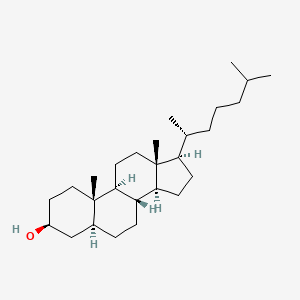| MeSH term | MeSH ID | Detail |
|---|---|---|
| Diabetes Mellitus | D003920 | 90 associated lipids |
| Diabetes Mellitus, Type 2 | D003924 | 87 associated lipids |
| Cataract | D002386 | 34 associated lipids |
| Hypercholesterolemia | D006937 | 91 associated lipids |
| Alcoholism | D000437 | 27 associated lipids |
| Brain Diseases, Metabolic | D001928 | 9 associated lipids |
| Biliary Fistula | D001658 | 13 associated lipids |
| Xanthomatosis | D014973 | 17 associated lipids |
| Xanthomatosis, Cerebrotendinous | D019294 | 14 associated lipids |
Dihydrocholesterol
Dihydrocholesterol is a lipid of Sterol Lipids (ST) class. Dihydrocholesterol is associated with abnormalities such as Exanthema, Morphologically altered structure, protrusion, Dehydration and Xanthoma. The involved functions are known as Regulation, Biochemical Pathway, Methylation, Metabolic Inhibition and Biosynthetic Pathways. Dihydrocholesterol often locates in envelope, Mitochondria, Lipid Bilayers, Host Cell and Membrane. The associated genes with Dihydrocholesterol are GRAP2 gene, PTP4A2 gene, HSD3B7 gene, MBD2 gene and IGF2BP3 gene. The related lipids are Sterols, Cardiolipins, Pregnanes, 7-hydroxy-4-cholesten-3-one and Hydroxycholesterols. The related experimental models are Mouse Model.
Cross Reference
Introduction
To understand associated biological information of Dihydrocholesterol, we collected biological information of abnormalities, associated pathways, cellular/molecular locations, biological functions, related genes/proteins, lipids and common seen animal/experimental models with organized paragraphs from literatures.
What diseases are associated with Dihydrocholesterol?
Dihydrocholesterol is suspected in Xanthoma, Xanthomatosis, Cerebrotendinous, Coronary heart disease, Exanthema, Morphologically altered structure, Dehydration and other diseases in descending order of the highest number of associated sentences.
Related references are mostly published in these journals:
| Disease | Cross reference | Weighted score | Related literature |
|---|
Possible diseases from mapped MeSH terms on references
We collected disease MeSH terms mapped to the references associated with Dihydrocholesterol
PubChem Associated disorders and diseases
What pathways are associated with Dihydrocholesterol
There are no associated biomedical information in the current reference collection.
PubChem Biomolecular Interactions and Pathways
Link to PubChem Biomolecular Interactions and PathwaysWhat cellular locations are associated with Dihydrocholesterol?
Visualization in cellular structure
Associated locations are in red color. Not associated locations are in black.
Related references are published most in these journals:
| Location | Cross reference | Weighted score | Related literatures |
|---|
What functions are associated with Dihydrocholesterol?
Related references are published most in these journals:
| Function | Cross reference | Weighted score | Related literatures |
|---|
What lipids are associated with Dihydrocholesterol?
Related references are published most in these journals:
| Lipid concept | Cross reference | Weighted score | Related literatures |
|---|
What genes are associated with Dihydrocholesterol?
Related references are published most in these journals:
| Gene | Cross reference | Weighted score | Related literatures |
|---|
What common seen animal models are associated with Dihydrocholesterol?
Mouse Model
Mouse Model are used in the study 'On the mechanism of accumulation of cholestanol in the brain of mice with a disruption of sterol 27-hydroxylase.' (BÃ¥vner A et al., 2010).
Related references are published most in these journals:
| Model | Cross reference | Weighted score | Related literatures |
|---|
NCBI Entrez Crosslinks
All references with Dihydrocholesterol
Download all related citations| Authors | Title | Published | Journal | PubMed Link |
|---|---|---|---|---|
| Berginer VM | [Cerebrotendinous xanthomatosis]. | 1992 | Zh Nevropatol Psikhiatr Im S S Korsakova | pmid:1333699 |
| Shah VG et al. | Comparisons of water quality parameters from diverse catchments during dry periods and following rain events. | 2007 | Water Res. | pmid:17428519 |
| Derrien M et al. | Origin of fecal contamination in waters from contrasted areas: stanols as Microbial Source Tracking markers. | 2012 | Water Res. | pmid:22673347 |
| Saim N et al. | Chemometric approach to validating faecal sterols as source tracer for faecal contamination in water. | 2009 | Water Res. | pmid:19896157 |
| Collinder E et al. | Influence of zinc bacitracin and Bacillus licheniformis on microbial intestinal functions in weaned piglets. | 2003 | Vet. Res. Commun. | pmid:14609263 |
| Björkhem I and Leitersdorf E | Sterol 27-hydroxylase deficiency: a rare cause of xanthomas in normocholesterolemic humans. | 2000 | Trends Endocrinol. Metab. | pmid:10856919 |
| Nikkilä K et al. | Sterol parameters as markers of liver function in primary biliary cirrhosis before and after liver transplantation. | 2005 | Transpl. Int. | pmid:15691276 |
| Fischer A et al. | Acid catalysed reactions of alcohols in acetic anhydride. | 1967 | Tetrahedron | pmid:4860123 |
| Ostrowitz A et al. | Studies of gallstone formation in the rabbit. | 1970 | Surg Forum | pmid:4936993 |
| Ren D et al. | Mechanism of cholesterol reduction to coprostanol by Eubacterium coprostanoligenes ATCC 51222. | 1996 | Steroids | pmid:8789734 |
